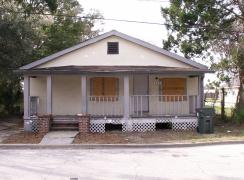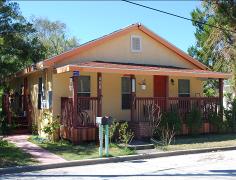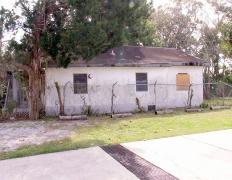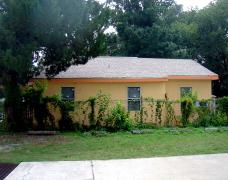






|
12 QUESTIONS: Michael Allen Andersen, Casa de Comienzo Fresco in Daytona Beach by: Steve Webster |
|
( - promoted by FWHN staff) Today, 37-year old Andersen heads Casa de Comienzo Fresco---Urban Revitalization for Emerging Neighborhoods, a small affordable housing developer focused exclusively on rehabbing dilapidated houses in neighborhoods near Bethune Cookman College to rent to Section 8 families. And he does it with a flair, as the before-and-after photos below show. We read about him---and wrote about him---here. Then we asked him 12 QUESTIONS: 1. How many affordable housing units do you currently own? Are they all occupied? Are they all Section 8 apartments? Do you or will you manage housing for other owners? Since I began in late February, I have purchased a duplex and a single family home, providing three units. The single-family home is undergoing reconstruction and I expect it to be completed in early September, the work on this home is more cosmetic than was School Street. Half of the 4-bedroom duplex is occupied.
(Left: the School St. duplex after rehab. Right: School St. before rehab. - Ed.) All the units I reconstruct are designed with low-income families in mind, using the best materials available. I like to use items and design concepts that I would use in my own home. I have not been approached to manage other properties yet, but am open to that if in a low-income neighborhood. There are many homes for sale, I think owners want to get out and invest elsewhere. |
|
|
|
2. How many units do you have under development or construction? Currently the 3 bedroom house is my focus, I am a very active participant in the entire process, I have no problem getting dirty and I don’t make my decisions from an air conditioned office, I prefer to make my decisions on the street, at the site with my employees and neighbors providing feedback. Attention to detail is very important to me, so I prefer to do one or two units at a time, so I can be there to make sure my ideas are implemented. I have a mental list of houses, in bad shape, in some of what are considered the worst areas that I want to acquire, beautify, and rid of drugs and illegal activity. I love a challenge. 3. Are you focusing on a specific geographic area and/or housing type? What are they? I like the area I am in now, there are 26+ churches in the area, the homes are older and small so space is a factor, but they generally have a nice sized lot. Providing a nice home plus a back yard is a great bonus for a family and of course, it is affordable for me to buy in these areas. 4. Are you doing only rehab? Have you considered new construction, and what factors influenced your decision? I prefer to do rehab, not only is it (in most cases) more cost effective, but it preserves the look and feel of the neighborhood. If I had the wherewithal to take vacant land and construct a 200-unit structure for low-income individuals, I would. However, I would not tear down 30 houses to do it. A neighborhood will lose its identity and the remaining residents can feel like outsiders in a neighborhood that took them generations to build. 5. What brought you to affordable housing in the first place, can you give us some of your background, and also what do you hope to achieve? I returned to Daytona Beach having spent 15 years in Manhattan after my grandfather, Richard Pennell, a builder by trade, passed away, and left me his home in South Daytona; it was a life-changing event for me. I left my good position in the corporate world to do something more meaningful with my life. Initially, I sought work in the non-profit field, and was going to do real estate investment on the side for profit---buy, sell, and move on. I was looking at multi-family units, and was troubled at what I found. I met with property owners that said their properties “pumped money.” The outside of the buildings looked ok but once inside I discovered living conditions to be deplorable. Everything from broken windows, holes in the floors and walls, to mismatched harvest gold and almond appliances, everything was just barely good enough. Low-income renters deserve more than just good enough. 6. In an email to us earlier, you stated some pretty profound philosophical foundations for your affordable housing program. Care to recall them for our readers? I can sum my strategy as enhancing the quality of life and practicing the golden rule. Everyone deserves quality of life regardless of income and credit score. Living conditions can have a strong impact on how you feel about yourself, where you live contributes to your identity. If you take a struggling family or single parent on a low or fixed income and rent them a deteriorating place to live, part of their self-esteem can crumble along with that house. Put that same family in a redone home for an affordable price, treat them with respect and they will naturally feel better about who they are and flourish. 7. Are you working solo? Who are the other members of your team? Are you working with any non-profit groups of agencies? I have funded all of these projects myself. These redeveloped homes are regarded as investment properties by banks so lending rates are higher; but I consider the homes I redo as investments in the community, the dividends they pay are worth more than dollars. I prefer to work with locals; there are a lot of qualified, licensed workers in the same community I am trying to restore. 8. Have you received any public funding or development or construction loans (beyond Section 8 vouchers) for your projects, and if so could you describe them? Are you currently seeking any public loans or grants (or considering it)? I began the process for a Rehab Mortgage thru the city for the School Street property but gave up after finding the process too arduous and time consuming. I am a relatively bright individual and gave up in frustration; I cannot imagine many homeowners are willing or able to jump thru so many hoops for a mere 15K at zero % interest. However, the process for a 5K Beautification Grant was much more user friendly and something I used at School Street. If I spend 10K to improve the outside, they will reimburse me 5K. It is a program that I encourage my neighbors to take advantage of. 9. Can you take us through a Section 8 'deal?' How does Section 8 work, both in general and in Volusia County? Has your experience been a positive one so far? Section 8 by definition is a federal housing program providing rental assistance to eligible families and elderly residents that allows them to rent units in the private rental market. These subsidies usually equal the difference between 30% of the household's adjusted income and the HUD-approved fair market rent. Section 8 has a stigma attached to it that some landlords shy away from. Most problems can be avoided with proper screening. I liken interviewing a tenant to interviewing an employee. Again, proper in-depth screening of all tenants, section 8 or not, is critical. I’d rather all my houses sit empty for months at a time than to move people in of questionable character. One thing I will not tolerate is illegal drug use, it is just a disaster waiting to happen, cause for immediate eviction proceedings and unfair to the community. Here is where being a proactive and present landlord is invaluable. I believe Section 8 to be a standardized program, it guarantees 70% of the rent will be paid. 10. If you think about replicating what you are doing in other communities around Florida, say someone in Baker County reads this and decides to act locally, what sort of advice would you offer an investor/builder/developer/property manager such as yourself, with your resources? What I am doing is expensive and a long-term investment. There are many people with more resources than me, that can and should get involved, but it takes more than cash, you also need vision, common sense and a desire to want to improve the quality of life. If you assess someone by their character and not by their income, you will do well. If you are only looking to profit, flipping condos may be more for you. I measure my success in the lives I change. 11. www.comienzo-fresco.com is an eclectic, whimsical web site that's a total departure from what's typical in housing. You say you want to 'make Section 8 fun,' which we applaud. How do you market your web site, how do consumers find their way to www.comienzo-fresco.com, and how did you arrive at that name? The website is new. Most traffic is probably directed by my e-mails to supply houses looking for a break on materials. I try to use high end, but cannot afford retail, and I am always at Habitat for Humanity looking for left over granite. Casa de Comienzo Fresco translates from Spanish as House of Fresh Beginnings, which fits what I want to do, provide families a fresh start. The reason I market my efforts with colorful cows has to do with the impression I was left with after visiting the Section 8 office. Talking thru thick Plexiglas was daunting; I found it to be impersonal and cold. If you look at the Section 8 brochure provided by Volusia County, it depicts a young, happy couple moving into a beautiful home, the reality can be much different. From that point, I decided that I want to be known for bright impossible color combinations, I want my houses to be inviting and to stand out on the block to demonstrate change is underway. The School Street property was considered a lost cause, now it is a beacon of vision. Word of mouth always works; craigslist and gosection8.com are where I put the finished product. I do not place ads in major local newspapers because I do not want to “import” tenants from other communities; I want to better the lives of the existing residents. 12. Do you see your affordable housing development program expanding or shrinking? Over the next three years, how do you expect your program to change? Will demand for Section 8 housing opportunities in your area grow or contract? There will always be a need for low-income housing. I have funded my first three units on my own and learned a lot. After the single-family home is completed, I will evaluate my next move, but I intend to continue improving low-income housing as a redeveloper or low-income housing advocate, either in conjunction with an investor with a similar vision or on my own if necessary. The St. Bethel apartment complex on Martin Luther King Blvd. would make a wonderful next project for the neighborhood. In addition, I would like to strike a deal that allows me to take control of some of the run-down, city owned properties and rehabilitate them for low-income residents. Once the neighborhood sees someone spending money to make it a better place, and stays put, people will naturally take more pride in their own homes, redevelopment is always contagious. |